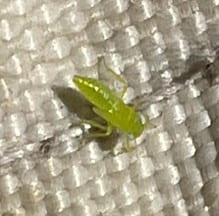–by Jeff Whitworth — Field Crops
Potato leafhoppers (PLH) started their annual migration back into Kansas about 7-10 days ago, at least in numbers that could be noticed. Potato leafhoppers are small lime green, wedge-shaped plant sucking insects (see pic 1-nymph) that have a characteristic white spot between their eyes on both adults (see pic 2) and nymphs. Adults have wings and readily fly when disturbed. Nymphs do not have wings but will quickly move to the underside of leaves or jump into the leaf litter below the canopy when disturbed. Females deposit eggs in stems and the tiny nymphs emerge ready to feed. Both nymphs and adults suck plant juices and in so doing inject a toxin into the plant. Signs of potato leafhopper feeding on alfalfa leaves then is often called “hopper burn”. This starts out as a yellowing at the leaf tip (see pic 3) but if feeding continues, it may cause the whole leaf/stem/plant to turn yellow and wilt which may significantly reduce nutrient quantity and quality. PLH is usually affect the 2nd-4th cuttings. Swathing is probably the best way to control PLH populations but if populations exceed the treatment threshold and the alfalfa won’t be ready to swath for 3 weeks or so, then an insecticide application may be justified.

Picture 1: PLH nymph

Picture 2: PLH Adult

Picture 3: “Hopper burn” on alfalfa leaves